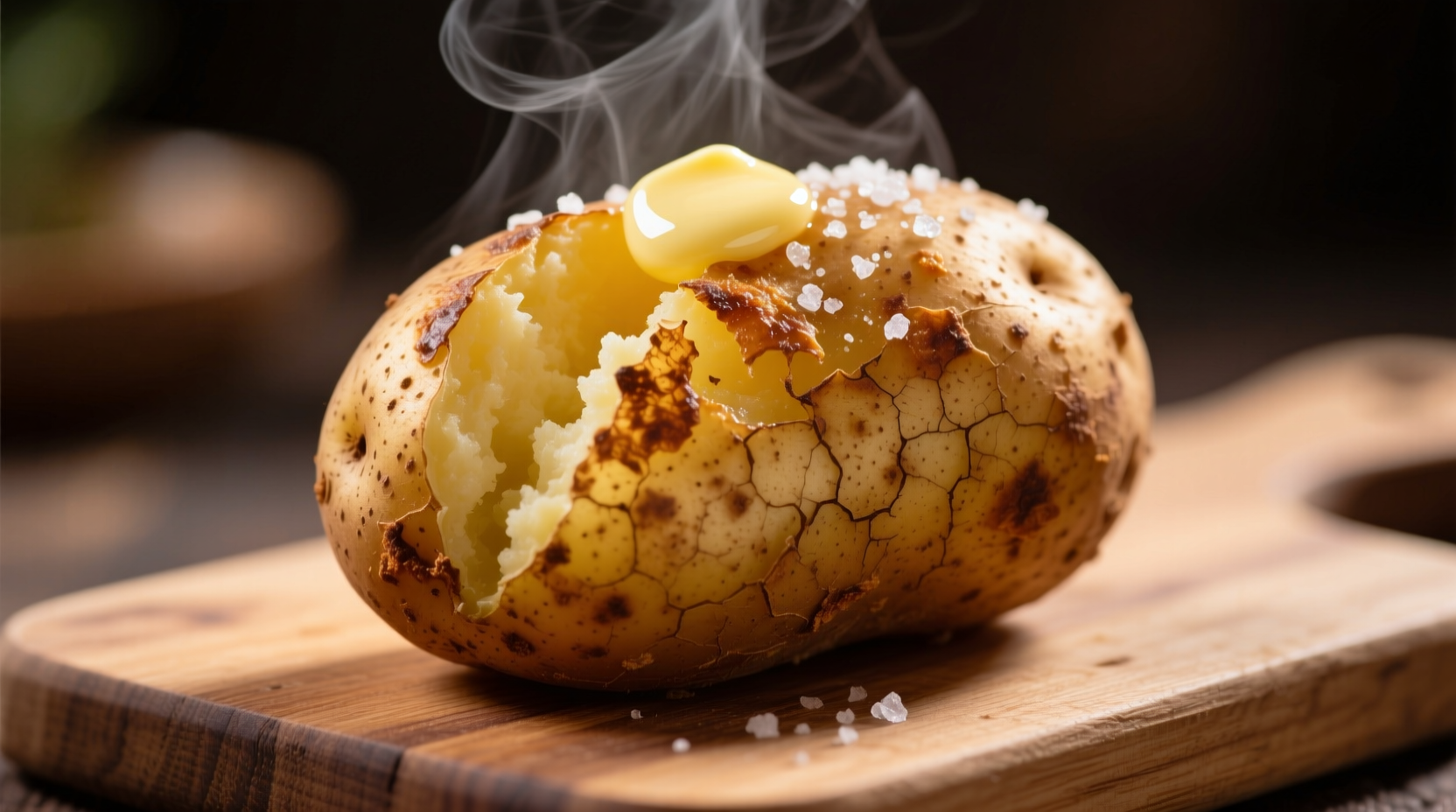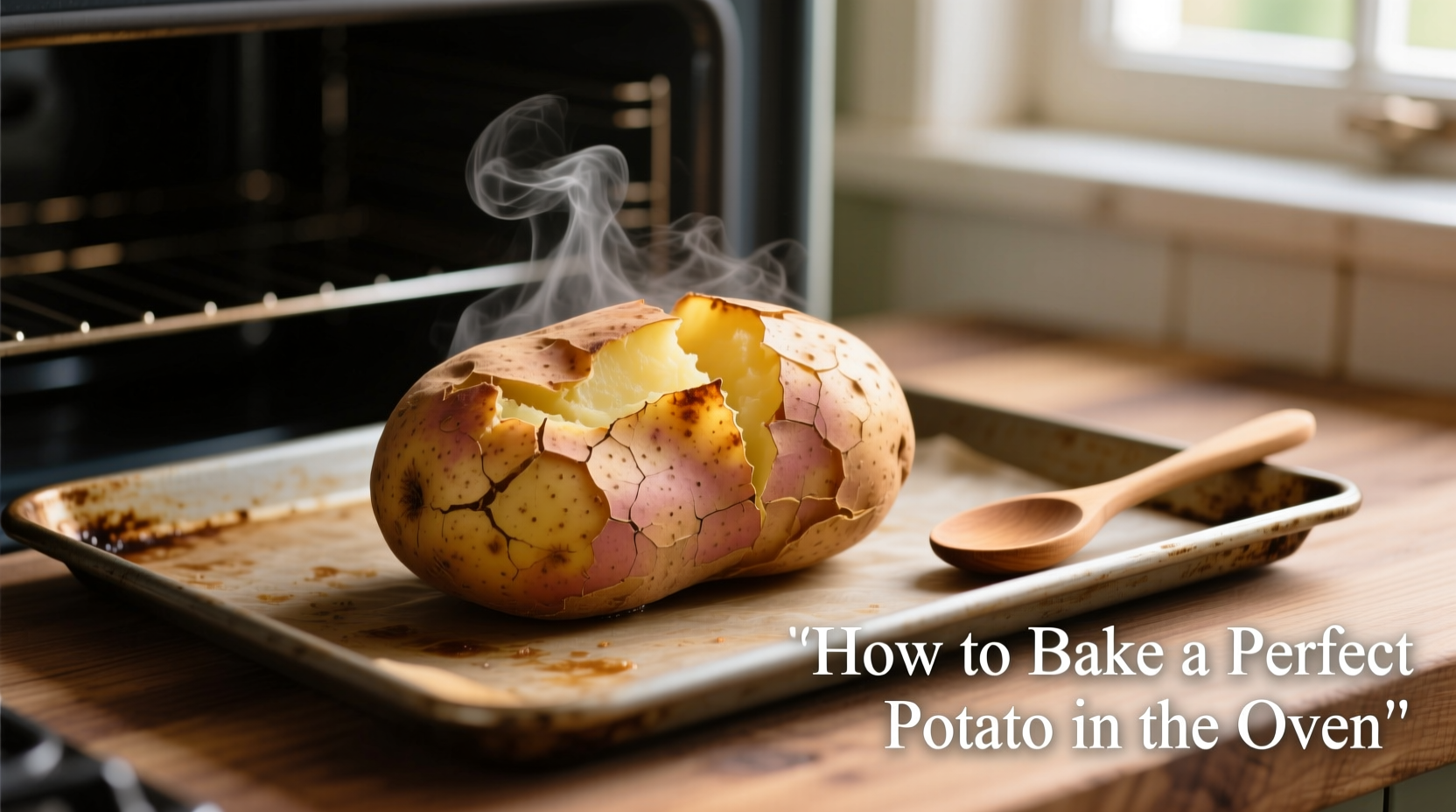The perfect oven-baked potato requires a medium-sized russet potato, 400°F oven temperature, and 45-60 minutes baking time. Pierce the skin, rub with oil, and bake directly on the oven rack for crispy skin and fluffy interior. Check doneness with a fork or thermometer (205-210°F internal temperature).
There's nothing quite like a perfectly baked potato straight from the oven—crispy skin giving way to fluffy, steaming interior. Whether you're preparing a weeknight dinner or elevating your Sunday roast, mastering this kitchen staple transforms simple ingredients into something extraordinary. In this guide, you'll learn the science-backed method professional chefs use to achieve consistently perfect baked potatoes every time, avoiding common pitfalls that lead to uneven cooking or disappointing results.
Why Oven Baking Beats Other Methods
While microwaves offer speed and air fryers provide crispiness, traditional oven baking creates the ideal balance of texture and flavor development. The slow, even heat of an oven allows for proper starch gelatinization throughout the potato while developing complex flavors through the Maillard reaction on the surface. According to the USDA Food Safety and Inspection Service, baking at proper temperatures also ensures food safety by eliminating potential pathogens.
Essential Preparation: Setting Up for Success
Before your potato ever touches the oven, proper preparation makes all the difference. This isn't just about cleaning—it's about understanding how each step affects your final result.
Choosing the Right Potato
Not all potatoes bake equally well. Russets (Idaho potatoes) remain the gold standard for baking due to their high starch content and thick skin that crisps beautifully. Here's how common varieties compare:
| Potato Type | Best For Baking? | Texture Result | Baking Time Adjustment |
|---|---|---|---|
| Russet (Idaho) | Excellent | Fluffy interior, crispy skin | Standard time (45-60 min) |
| Sweet Potato | Good | Creamy, moist | +10-15 minutes |
| Yukon Gold | Fair | Buttery, less fluffy | -5-10 minutes |
| Red Potato | Poor | Dense, waxy | Not recommended |
Proper Cleaning and Drying Technique
Wash potatoes thoroughly under cool running water using a vegetable brush to remove dirt. The critical step many skip: completely drying the potato. Moisture on the skin creates steam during baking, preventing that desirable crispness. Pat potatoes dry with a clean kitchen towel—this simple step makes a noticeable difference in final texture.
The Poking Process: Science Behind the Prick
Using a fork, pierce the potato 6-8 times around its surface. This isn't just tradition—it's food science. As potatoes heat, internal moisture turns to steam, building pressure. Without these vents, steam pressure can cause your potato to burst dramatically in the oven. The National Center for Home Food Preservation confirms this safety step prevents potential messes and ensures even cooking.

The Baking Process: Step-by-Step Guide
Now that your potato is properly prepared, let's transform it from raw ingredient to culinary delight through precise baking techniques.
Temperature and Placement Strategy
Preheat your oven to 400°F (204°C)—this temperature provides the ideal balance between exterior crisping and interior cooking. Place potatoes directly on the oven rack with a baking sheet on the rack below to catch any drips. This placement allows hot air to circulate completely around the potato, ensuring even cooking. For multiple potatoes, space them at least 1 inch apart.
Precision Timing Guidelines
Baking time depends primarily on potato size, not just variety. Use this foolproof timing method:
- Small potatoes (5-6 oz): 40-45 minutes
- Medium potatoes (8-10 oz): 45-55 minutes
- Large potatoes (12+ oz): 55-70 minutes
Rotate potatoes halfway through baking for even exposure to heat sources. For the crispiest skin, rub potatoes with 1 teaspoon of olive oil and sprinkle with coarse salt before baking—this creates a delicious crust through controlled dehydration.
How to Test for Perfect Doneness
Don't rely solely on timing. Use these professional methods to check readiness:
- Fork test: Insert a fork into the thickest part—it should slide in with almost no resistance
- Squeeze test: Using oven mitts, gently squeeze the potato—it should yield slightly
- Thermometer test: Insert an instant-read thermometer into the center—205-210°F (96-99°C) indicates perfect doneness
Finishing Touches: Transforming Good into Great
The moment your potato emerges from the oven presents opportunities to elevate your creation from basic to exceptional.
Cutting Technique Matters
Use a sharp knife to make a lengthwise slit across the top, then press the ends toward the center. This creates the perfect pocket for fillings while maintaining structural integrity. Wait 5 minutes after removing from oven before cutting—this allows residual heat to finish cooking the very center without overcooking the edges.
Classic Topping Combinations
While butter and sour cream remain classics, consider these chef-recommended pairings that complement rather than overwhelm the potato's natural flavor:
- Traditional: Salted butter, chives, and a dollop of sour cream
- Mediterranean: Olive oil, feta cheese, and roasted garlic
- Southwest: Black beans, corn, cilantro, and lime zest
- Breakfast style: Crispy bacon, scallions, and a fried egg
Troubleshooting Common Baking Issues
Even with careful preparation, challenges can arise. Here's how to address them:
Uneven Cooking
If your potato is done on one side but raw on the other, your oven likely has hot spots. Solution: Rotate the potato 180 degrees halfway through baking and consider using an oven thermometer to verify accurate temperature.
Soggy Skin
This usually occurs when potatoes aren't dried thoroughly before baking or when placed on a baking sheet instead of directly on the rack. Prevention: Ensure complete drying and proper placement. For extra-crispy skin, some chefs recommend baking directly on coarse salt spread on a baking sheet.
Undercooked Center
If the center remains firm after the recommended time, your oven might run cool or the potato was particularly dense. Solution: Continue baking in 5-minute increments, checking frequently. Never microwave to finish cooking—this creates an unpleasant texture contrast.
Storage and Reheating Best Practices
Properly stored baked potatoes maintain quality for up to 5 days in the refrigerator. Always remove toppings before storing. For best reheating results:
- Oven method: 375°F for 15-20 minutes (best for texture)
- Air fryer: 350°F for 8-10 minutes (excellent for crispy skin)
- Avoid: Microwave reheating creates uneven texture and sogginess
Frequently Asked Questions
Can I bake potatoes at a lower temperature for longer?
Yes, but with trade-offs. Baking at 350°F for 60-75 minutes produces more evenly cooked potatoes but with less crispy skin. The lower temperature slows the Maillard reaction that creates desirable browning and complex flavors. For optimal results, stick with 400°F as the ideal balance of texture and flavor development.
Why do some recipes suggest wrapping potatoes in foil?
Foil wrapping creates a steaming effect that produces softer skin and moister interior, similar to boiled potatoes. Professional chefs generally avoid foil for traditional baked potatoes because it prevents the skin from crisping properly. Use foil only if you specifically want a softer texture, such as when preparing potatoes for mashing.
How can I speed up the baking process without sacrificing quality?
Partially microwave the potato for 3-5 minutes (depending on size) before finishing in a 400°F oven for 20-25 minutes. This reduces total time while maintaining oven-baked texture. Never skip the oven step entirely, as microwaving alone creates inferior texture and flavor development compared to proper baking.
Are baked potatoes healthy?
Yes, when prepared simply. A medium baked russet potato contains about 168 calories, 4.3g fiber, and significant potassium and vitamin C. The healthiest preparation involves baking with skin (which contains half the fiber) and minimal added fats. Avoid loading with excessive butter, sour cream, or cheese to maintain nutritional benefits.











 浙公网安备
33010002000092号
浙公网安备
33010002000092号 浙B2-20120091-4
浙B2-20120091-4